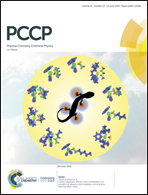Self-assembly and structural manipulation of diblock-copolymer grafted nanoparticles in a homopolymer matrix†
Abstract
Detailed coarse-grained molecular dynamics simulations are performed to investigate the structural and mechanical properties of nanoparticles (NPs) grafted with an amphiphilic AB diblock copolymer, with the A-block being compatible with NPs and the B-block being miscible with a homopolymer matrix. We systematically investigate the effects of the grafting density (Ng), the component ratio (α) and the flexibility of the grafted diblock copolymer on the structural and mechanical properties of polymer nanocomposites (PNCs). Interestingly, we observe that the grafted NPs can form a core–shell like structure attributed to the adsorption of the A-blocks onto the NPs, validated by the radial distribution function of the A and B blocks away from the surface of the NPs. The integrity of the core–shell structure is influenced by the grafting density and the component ratio of the grafted chains. The core–shell structure of the NPs becomes more perfect with greater Ng. The morphology of the NPs is shifted from a network structure to an isolated or well dispersed state upon increasing the grafting density. Meanwhile, we analyze the evolution of the morphology of the NPs during the uniaxial tensile process by calculating the number of neighboring NPs as a function of strain, thus finding that the NP network is broken-up at low grafting density, while only a little change is observed at high grafting density. Upon increasing the component ratio of the B-block to the A-block, the dispersion of the NPs becomes better, characterized by the radial distribution function of NPs–NPs, NPs–A-blocks, NPs–B-blocks, NPs–matrix, the number of neighboring NPs and the snapshots. Lastly, by changing the B-block from being flexible to stiff, the core–shell structure of the NPs disappears after the formation of a typical capsule morphology. This capsule-ordered structure becomes more prominent with the increase in Ng. Remarkably, compared to the effect of the core–shell morphology on the mechanical properties, the capsule morphology reinforces the mechanical properties more obviously. In general, this simulation work provides a deep insight into the structural and mechanical properties of NPs grafted with diblock copolymer chains, in the hope of providing some guidance on the design and preparation of high-performance PNCs.



 Please wait while we load your content...
Please wait while we load your content...